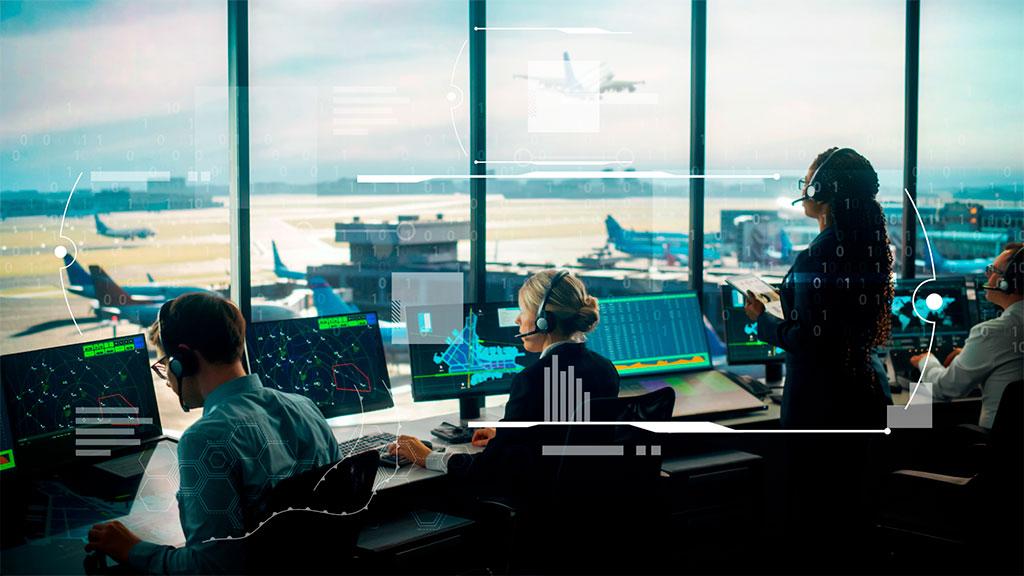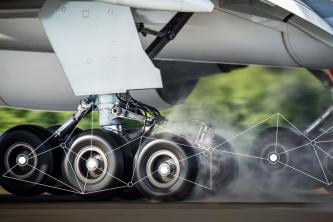Enabling the Power to Predict for Connected Aviation

Flight departures and arrivals. Aircraft maintenance. Sustainability. What do all of these aviation keywords have in common? Data generation and the power to predict. Wouldn't it be great if passengers knew exactly when their planes were going to land? Or if airlines could avoid flight delays because of unexpected aircraft maintenance events? It's fair to say that knowledge is power, but what role does data, knowledge and the power to predict play in the connected aviation ecosystem?
For the last decade, the aerospace industry has seen a transformation with the introduction of the connected aviation ecosystem. This new paradigm has led to an interconnected and integrated framework that relies heavily on advanced technology to improve safety, efficiency, and sustainability. One of the most significant benefits of the connected aviation ecosystem is the application of predictive technologies to improve the passenger journey.
"With the power to predict, we can help the aviation industry be more efficient, improve the passenger experience and reduce environmental impact," said Jennifer Schopfer, president of Connected Aviation Solutions for Collins Aerospace.
The power to predict begins with big data
The power to predict is fueled by several key factors and data plays a vital role. Connected aviation brings together a range of cutting-edge technologies, such as machine learning (ML), artificial intelligence (AI), and data analytics. By integrating these advanced technologies, real-time monitoring becomes possible not only for aircraft and their systems but also for collecting and analyzing the vast amount of data generated within the aviation ecosystem. This encompasses data from airlines, airports, air traffic management, and more, resulting in billions of data points.
Harnessing this data is only the start though. Stakeholders must possess the ability to interpret and comprehend its significance, transforming raw data into actionable knowledge.
Unlocking the benefits of predictive technology within the connected aviation ecosystem
At the forefront of the AI revolution are neural networks, which, in a sense, represent the neural functions of the human brain. FlightAware, a Collins company, has developed proprietary neural network models for improved aviation predictions. By integrating reliable data like estimated time of arrival (ETA) and taxi-out predictions (the time it takes to go from gate to wheels-up), all stakeholders can benefit. Advanced notice enables smarter decisions.
Smart decisions can also lead to improved efficiency, which is another key benefit of predictive analytics. Using knowledge obtained from data enables various touchpoints throughout the connected aviation ecosystem to optimize operations and flight plans, which then leads to reduced flight delays, cancellations and overall flight costs.
 Using ML algorithms, blended with years of historical data and real-time status of an aircraft's position, traffic and weather, airports, airlines and ground personnel can predict when an aircraft will arrive at the gate hours in advance. This ability enables tight turnarounds, better on-time departures and fewer delays.
Using ML algorithms, blended with years of historical data and real-time status of an aircraft's position, traffic and weather, airports, airlines and ground personnel can predict when an aircraft will arrive at the gate hours in advance. This ability enables tight turnarounds, better on-time departures and fewer delays.
On-time arrivals and departures are undoubtedly important to passengers, airlines and airports alike. And the same goes for ensuring a smooth passenger journey from check-in to baggage claim. With Collins' Airplan™ solution, resources such as stands, gates, check-in desks and baggage belts are managed in one application. And when combined with FlightAware ForesightSM—which ensures more accurate flight ETAs and taxi-out time calculations—passengers and airlines benefit from more accurate aircraft arrival times, which eases airport congestion and reduces turnaround time.
"When all of these connection points work together, it means ground crews are available when a flight lands, gate agents are at the ready and baggage carousel assignments are more accurate," Schopfer said. "What's more is that with the power to predict, tasks like updating flight plans, identifying potential turbulence and receiving traffic notifications make rerouting flights en route more achievable."
Unlocking deeper product data enables smarter and more communicative features. Prognostic and Health Management (PHM) is gaining traction in the connected aviation ecosystem, monitoring various systems like air management, electrical systems, wheels and brakes and cabin systems. PHM helps airlines anticipate issues, enabling proactive part provisioning and scheduled maintenance during routine overnight inspections and maintenance.
Enabling the Power to Predict
Intelligent cabin solutions are making a big entry as insights and predictions for on-board catering and power efficiency are made possible. With the 2023 Crystal Cabin award-winning InteliSence™, deep-learning AI software, video and sensor technology improve food and beverage service. Anticipating when a passenger needs a drink refilled or more accurately predicting catering levels based on passenger preferences demonstrate how valuable this savvy technology is to both cabin service and the passenger experience.
Collins' wireless connectivity solutions for galley inserts (frequently known as cooking appliances on an aircraft) are a great example of how the power to predict improves the passenger experience. With this solution, real-time communication of operational and health data remotely troubleshoots things like water and power supplies, reducing faults and allowing for early prediction and notification of potential failures. Previously, these products had no connection to the aircraft. Now, proactive repairs can be scheduled during regular maintenance checks, avoiding flight delays caused by unexpected failures.
Similarly, Ascentia®, a leading PHM tool available from Collins, provides predictive and prescriptive information for many of the world's most popular aircraft platforms and systems. For airlines, this knowledge helps avoid operational disruptions and schedule repairs and maintenance during non-peak operating hours, potentially reducing up to 30% of maintenance-driven delays and cancellations on systems covered by Ascentia and also saving up to 20% of maintenance costs.
 Another example of how Collins is enabling the power to predict features aircraft wheels and brakes. Most aircraft today do not have sensors to determine brake life. Instead of airlines relying solely on manual inspections—which can lead to premature brake removal—Collins is leveraging FlightAware data to introduce a predictive brake wear pin analytic. This alternative method monitors brake usage and allows airlines to keep brakes in service longer and minimize impact to carbon footprint, all while reducing the need for constant manual monitoring.
Another example of how Collins is enabling the power to predict features aircraft wheels and brakes. Most aircraft today do not have sensors to determine brake life. Instead of airlines relying solely on manual inspections—which can lead to premature brake removal—Collins is leveraging FlightAware data to introduce a predictive brake wear pin analytic. This alternative method monitors brake usage and allows airlines to keep brakes in service longer and minimize impact to carbon footprint, all while reducing the need for constant manual monitoring.
Just as the power to predict can minimize carbon footprint for wheels and brakes, it also has the potential to significantly reduce commercial aviation's overall environmental impact. It's estimated that contrails make up more than half of the global warming impact of aviation. By merging contrail creation data with FlightHub™, Collins is seeking to minimize contrail formation, reducing the impact of global warming. And then with FlightHub's Flight Profile Optimization tool, the most efficient flight routes can be selected by pilots to minimize fuel consumption and reduce carbon emissions. In fact, Collins is currently in a trial for this solution with a North American airline, observing greater than 1% fuel and CO2 emission savings.
"Data, knowledge and the power to predict all play a crucial role in the connected aviation ecosystem," said Schopfer. "ML, AI, and data analytics are going to drive the data transformation in the aviation industry and the informed predictions that come out of it will lead to a profound change in aviation as we know it today."




